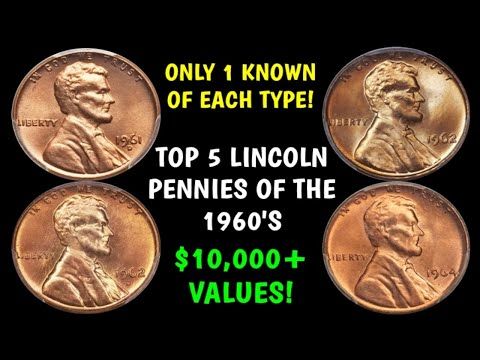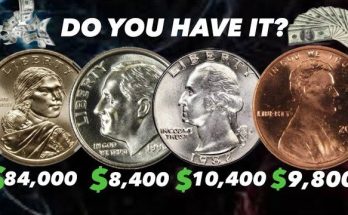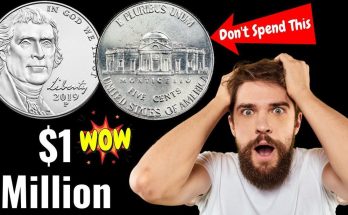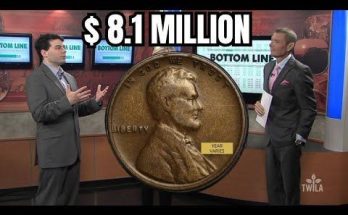The image above features four stunning Lincoln cents from the 1960s, highlighting the allure and potential value of rare pennies that many people might overlook in their everyday change. The bold text “ONLY 1 KNOWN OF EACH TYPE!” and “$10,000+ VALUES!” captures the excitement surrounding these small but valuable pieces of American history. While the image references some of the rarest Lincoln cents from the 1960s, the 1970 Lincoln cent stands out as one of the most intriguing coins in modern U.S. numismatic history — a small copper coin that could be worth thousands of dollars if you happen to find the right variety.
Let’s explore why certain 1970 Lincoln pennies are so rare, how to identify them, and what makes them worth such impressive amounts of money.
A Brief History of the Lincoln Cent
The Lincoln cent, first introduced in 1909 to honor Abraham Lincoln’s 100th birthday, has remained one of the most enduring designs in U.S. coinage. By 1970, the coin had already seen several design and composition changes — most notably the switch in 1959 from the Wheat Ears reverse to the Lincoln Memorial design. The 1970 Lincoln cent, part of the Memorial series, may appear ordinary at first glance, but certain minting varieties produced that year have become extremely valuable due to minting errors and differences in die production.
The Key Varieties: 1970-S Small Date and Large Date Cents
The 1970-S Lincoln cent, minted in San Francisco, exists in two main varieties — the Small Date and Large Date. The differences between them are subtle, but collectors can identify them by examining the date closely:
-
On the Small Date, the top of the “7” is level with the “0” in “1970,” and the word LIBERTY appears weak or lightly struck.
-
On the Large Date, the top of the “7” sits higher than the “0,” and LIBERTY is bolder and more clearly defined.
While both types were produced for circulation and proof sets, the 1970-S Small Date Proof is particularly sought after, especially when found in pristine condition. Proof coins were specially made for collectors, struck with polished dies to give them a mirror-like finish. If you discover a genuine Small Date Proof in flawless condition, it could be worth hundreds to thousands of dollars, depending on the grade.
The Holy Grail: 1970-S Small Date Doubled Die Obverse
The true treasure among the 1970 pennies is the 1970-S Small Date Doubled Die Obverse (DDO). This rare error coin displays strong doubling on the date and the inscriptions LIBERTY and IN GOD WE TRUST. The doubling occurred during the die creation process, when the hub struck the die more than once in slightly misaligned positions. Only a handful of these coins are known to exist, making them exceptionally valuable.
High-grade examples of the 1970-S Small Date DDO have sold for over $10,000, with some proof specimens commanding even higher prices at major auctions. This is why coin enthusiasts and collectors are constantly on the lookout for this elusive variety.
1970 Philadelphia and Denver Cents
In addition to the San Francisco Mint, both the Philadelphia (“no mint mark”) and Denver (“D”) Mints produced Lincoln cents in 1970. While these coins are generally more common, they too can have errors or varieties that increase their value. Look out for:
-
Off-center strikes, where part of the design is missing.
-
Double dies, showing clear doubling on letters or numbers.
-
BIE errors, where a small die crack appears between the letters “B” and “E” in LIBERTY, forming what looks like a tiny “I.”
While these errors might not reach five-figure prices, they can still be worth anywhere from $10 to several hundred dollars, depending on the severity and condition of the coin.
What Makes 1970 Pennies So Special?
The early 1970s were a transitional period for U.S. coin production. The Mint was experimenting with die-making techniques, which led to a number of interesting varieties and minting anomalies. The 1970-S pennies, in particular, were struck with dies that showed minor inconsistencies — perfect conditions for collectible error coins.
Because many of these varieties were not identified until years later, they can still occasionally be found in circulation or in old coin jars, making the hunt for a 1970-S Small Date or Doubled Die penny an exciting opportunity for anyone interested in coin collecting.
How to Check Your 1970 Pennies
To determine whether your 1970 penny is valuable:
-
Look at the mint mark: If it has an “S” under the date, it was struck in San Francisco — that’s the one with the rare varieties.
-
Compare the date: Use a magnifying glass to check whether the top of the “7” is level with the “0” (Small Date) or higher (Large Date).
-
Search for doubling: Look closely at “LIBERTY,” “IN GOD WE TRUST,” and the date. Strong doubling is a clear sign of the valuable DDO variety.
-
Check condition: Coins with no scratches, dings, or discoloration are worth much more, especially if they still shine like new.
If you think you’ve found a valuable coin, it’s wise to have it graded by a professional service such as PCGS (Professional Coin Grading Service) or NGC (Numismatic Guaranty Company). A certified grade can dramatically increase your coin’s market value and buyer confidence.
Conclusion
The 1970 Lincoln cent may seem like just another penny, but under the right circumstances, it can be a miniature fortune. The 1970-S Small Date Doubled Die Obverse remains one of the most famous and valuable modern penny varieties, commanding prices well over $10,000. Even more common 1970-S proof and mint-state coins can be worth collecting, especially in high grades.
So before you spend that old penny sitting in your change jar, take a closer look — you might be holding a piece of numismatic history worth far more than a single cent.
Caption suggestion:
“Check your pocket change! The rare 1970-S Small Date and Doubled Die pennies could be worth thousands of dollars. Don’t overlook these little copper treasures — one might just make you rich!”



